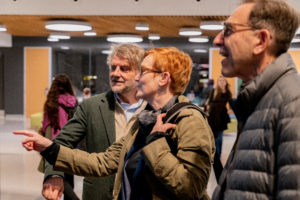
On November 20, 2019, Northeastern University hosted the debut U.S. presentation of a first-of-its-kind interactive digital installation of the famous Codex Atlanticus—the most extensive existing collection of drawings and text by Renaissance artist, Leonardo da Vinci. The masterpiece follows his works around the subjects of math, science, art, engineering, and the humanities from 1478 to 1519, though these subjects would have been complementary rather than more formally distinct areas of inquiry in the period. Students, faculty, and the general public had the opportunity to access and participate with one of the world’s greatest sets of texts in high resolution by leveraging the software’s extensive metadata framework.
The Codex, especially in its digitized format, which can be rearranged by both content and chronology, unlocks a sense of who Leonardo da Vinci was and what areas he was interested in throughout his life. The installation gave people an up-close look at how Leonardo would work on the same subject over and over again with a focus on experimentation, iteration, and observation: part of the artistic and scientific process simultaneously. While there is no substitute for a material encounter with the original, says Amy Halliday, Northeastern’s Director of the Center for the Arts, this installation granted new and significant forms of access to Leonardo’s work across often-insuperable barriers of time and space.
After the unveiling, an interdisciplinary panel led by Director of the Center of Design, Paolo Ciuccarelli and Northeastern faculty, alongside the key partners who developed the Codex application, allowed attendees to reflect and expand on the discussion. Amy Halliday commented further:
This was a brilliant example of how CAMD catalyzes both the discussion and manifestation of creative practice as research.
She continued, “Much as Leonardo’s work was based on close observation, discovery, creative curiosity, and iteration, in this project we see important cultural resources being shared, studied, and accessed in new ways through innovative design practices and data visualization. And, what is more, the public event offered opportunities for the audience to give feedback and suggestions for iteration and elaboration in the application. For a lot of young people, they’re actually more comfortable with forms of digital literacy… And maybe this is a gateway to their first engagement with Leonardo!”
Associate Professor of Architecture and Art & Design, Cammy Brothers added, “Leonardo da Vinci is a fascinating figure in part because he made his living as a painter but today we tend to think of him, at least in popular culture, primarily as an inventor and scientist. In the Renaissance, the distinction between art and science didn’t exist, they were both parts of the practice of observation. She continued, “I teach a course in the spring on exactly this topic, The Science of Art and the Art of Science (ARTH 1400), in which Leonardo is a protagonist.”

In the application, viewers are able to look through unbound pages in any order, creating a unique perspective and a new learning experience. The installation was organized by Northeastern University, Professor Paolo Ciuccarelli and CAMD’s Center for Design and Center for the Arts, with sponsorship from the Italian Consulate and the Office of the Provost, and the original application was developed by a partnership between the Biblioteca Ambrosiana and the Milan-based design firm The Visual Agency.
“The Codex Atlanticus application opens new possibilities to explore the complexity of such deep content,” said Matteo Bonera, Creative Director of The Visual Agency. “The design of the application has opened a new paradigm to data visualization: the general overview offers a unique representation of the evolution of Leonardo da Vinci’s thought; while providing easy access to his work to people with no previous literacy.”
Mons. Francesco Braschi, of the Biblioteca Ambrosiana, was part of the panel, along with Bonera. He added, “by means of the software developed by The Visual Agency, such an extremely sophisticated tool—and yet simple for the users’ experience—today we can look deeper inside the mind of Leonardo, learning his leading interests in the various times of his life, and even detecting the goals he was not able to achieve. Indeed, a thorough examination of all the desires, projects, plans conceived by him shows how many of his presumptive inventions and discoveries were… just a draft.”
And who knows where these “drafts” may take us next? The installation was featured in Northeastern’s Interdisciplinary Science & Engineering Complex (ISEC) atrium.


